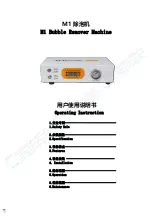
F-1031, Section 2449
Page 14 of 18
Pump (Continued)
Problem
Possible Cause
Recommended Action
Pump fails to prime or
loses prime (con’t)
Defective priming valve
A worn or damaged priming valve may leak and cause pump to
lose prime.
Consult primer instructions for priming valve repair.
Improper clearance in rotary gear
or vane primer
After prolonger service, wear may increase primer clearance re-
duce efficiency.
Refer to primer instructions for adjusting primer clearance.
Engine speed too low
Refer to instructions supplied with primer for correct priming
speeds. Speeds much higher than those recommended do not
accelerate priming, and may actually damage priming pump.
Bypass line open
If a bypass line is installed between the pump discharge and wa-
ter tank to prevent pump from overheating with all discharge
valves closed, look for a check valve in the line. If valve is stuck
open, clean it, replace it, or temporarily block off line until a now
valve can be obtained.
Lift too high
Do not attempt lifts exceeding 22 feet (6.7m) except at low
altitudes and with equipment in new condition.
End of intake hose not
submerged deep enough
Although intake hose might be immersed enough for priming,
pumping large volumes of water may produce whirlpools, which
will allow air to be drawn into intake hose.
Whenever possible, place end of intake hose at least two feet be-
low water source.
High point in intake line
If possible, avoid placing any part of intake hose higher than
pump inlet. If high point cannot be prevented, close discharge
valve as soon as pressure drops, and prime again. This
procedure will usually eliminate air pockets in intake line, but it
may have to be repeated several times.
Primer not operated long enough
Refer to instructions supplied with primer for required priming
time. The maximum time for priming should not exceed 45 sec-
onds for lifts up to 10 feet (3.0m).
Insufficient capacity
A. Engine and pump
speed low at full
throttle
Insufficient engine power
Engine requires maintenance.
Check engine in accordance with manufacturer’s instructions sup-
plied with truck.
Engine operated at high altitudes and/or high air temperatures.
Engine power decreases with an increase in altitude or air tem-
perature, except for turbo charged engines.
Adjusting carburetor or changing carburetor jets (or injector noz-
zles) may improve engine performance. Consult with
engine manufacturer.
Discharge relief valve set
improperly
If relief valve is set to relieve below desired operating pressure,
water will bypass and reduce capacity. Adjust relief valve in ac-
cordance with instructions supplied with valve.
Transfer valve set improperly
(Does not apply to single stage
pumps)
Place transfer valve in VOLUME (parallel) position when pumping
more than two thirds rated capacity.
When shifting transfer valve, make sure it travels all the way into
new position. Failure of transfer valve to move completely into
new position will seriously impair pump efficiency.
Truck transmission in too high a
gear
Consult vehicle instructions for correct pump gear. Pump
usually works best with transmission in direct drive.
If truck is equipped with an automatic transmission, be sure trans-
mission is in pumping gear.
Troubleshooting Guide




































